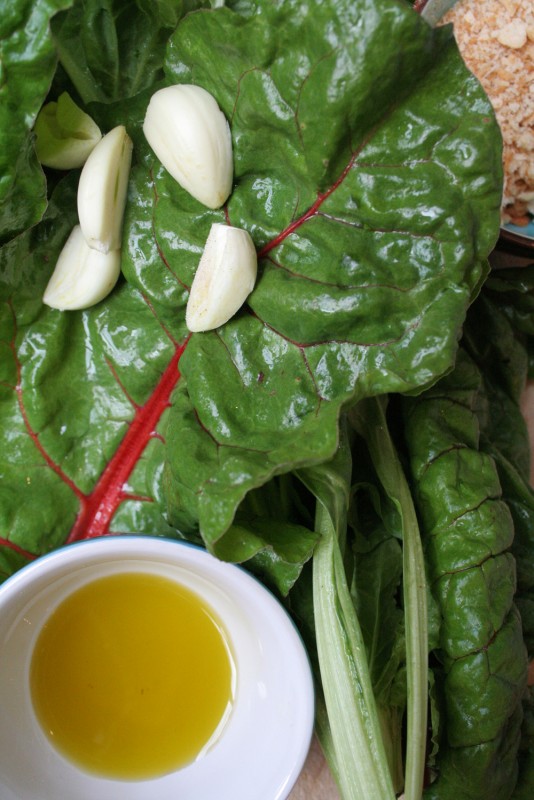Cheering for Chard

There they are, dressed to kill, their billowy leaves gently bending their crimson red stalks nearly to the ground, as the late spring wind whips unseasonably through my garden on this fine sunny day. Let not the sun betray, however, for it’s cold outside. It’s so cold in fact that I’ve resorted to winter ways. I’ve built a fire in the fireplace and have candles lit all around, to give the notion of warmth. It’s hardly what one would consider normal for this season.
As I survey my garden with thoughts of supper in my mind, I look to the fine and well-dressed vegetable, ruby Swiss chard. It’s a natural for a cold day because it responds so well to heat, warming one up whether it’s turned into soup, simply braised, added to an omelet, or folded into a béchamel for one of those wondrous creamy French inspirations.
The list of ways to prepare Swiss chard (Beta vulgaris, Cicla group), a variety of the beet family that the French call bettes, or blettes, could go on. This vegetable, with its dramatically large leaves and wide stalks, is a denizen of spring and summer, and it has just begun appearing at the market, where it will stay through September. I am thrilled, since my enthusiasm for the vegetables of winter and early spring has clearly begun to fade. Thank goodness, I say secretly to myself, I don’t have to eat any more celery root for a while (though I adore it for most of the year), nor parsnip, Jerusalem artichoke, nor winter turnip. A new page has turned, a new leaf emerged. Though already nearly June, it is finally well and truly spring.
This prompts a moment of reflection. What non-cooks may not realize is that for two months out of the year there really is nothing in the fruit or vegetable realm to eat. Come March, we’ve all had it with root vegetables, which in turn have had it with us. They’re slightly wrinkled on the outside, a bit spongy on the inside, and their gorgeous flavor has dimmed. Leeks are about to go to seed, while beets appear soft. Carrots are sprouting, onions are sending up green shoots, the faithful shallot lets us down and we won’t even mention the tragedy of garlic.
It’s a most trying time, those two months. I used to schedule cooking classes in April to capitalize on the world’s fascination with April in Paris, but I stopped, because there really isn’t anything to eat, certainly not enough to justify a week’s worth of culinary discovery.
So what do we all do, here in this vast culinary waste moment? We eat a lot of tender salads made from early lettuces. We give in and buy an early cherry tomato (which has actually become a year-round vegetable), we pounce on the first radishes, and dream about the first peas even as we avoid those in the marketplace, which usually have been shipped from very far away.
Of course it’s not all bad, because the noble asparagus comes to the rescue. But days are truly grand when Swiss chard begins to grow, decorating gardens and farm stands—it comes with stalks that are creamy white, vivid red, bright yellow or nearly black, and they all taste much alike. Chard begins quite early in the spring, with shoots so tiny they’re barely visible—except to the vegetable-starved. Once they’re up, though, they grow with wild abandon so that by now the plants are thick, lush and abundant. All that’s required is to selectively cut the leaves so that the plant stays intact. That way, it can be on the menu for a long time.
When I speak with my French friends about Swiss chard, they have no idea what I’m referring to. That got me to thinking about the Swiss part of the name. I turned to my friend and usual vegetable authority, Elizabeth Schneider. Her book Vegetables from Amaranth to Zucchini has all the answers. Neither she nor any other vegetable authority can really understand the moniker “Swiss” either, though the Swiss have been growing it since the 16th century. But since Aristotle was among the first to record its virtues, it might easily have been called Greek chard instead.
In any case, whatever its name it is a gorgeous vegetable and the French love it. In the southwest they tend to combine it with dried fruit and nuts and wrap it in pastry. In Normandy cooks cloak it in béchamel sauce or simply simmer it in cream. In other parts of the country it might be puréed into a velouté, or layered with ham in a gratin, or tucked inside a lamb shoulder before grilling.
I tend toward the Mediterranean approach, braising it with garlic and olive oil and then sprinkling it with toasted breadcrumbs before serving. It’s simple to prepare, delicious to eat, and it’s perfect either on its own or accompanying grilled meat or fish.
The first step in its preparation, whether you pick it or buy it, is to soak it in water with a bit of vinegar in it. This is a good rule for any vegetable, as vinegar in the water chases away all the garden creatures. Once soaked for five or ten minutes, it needs rinsing. All that’s left to do then is trim away the stems. I dice these and cook them with garlic in olive oil until they’re almost tender. Then I cut the leaves in thin strips and add them to the pan to cook until they’re tender too. A sprinkling of salt and a pinch of hot red pepper flakes or hot paprika and they’re almost ready for the table.
The final touch is to turn up the heat to high and evaporate most of the liquid in the pan, shaking it and the chard as you do. Then transfer it to a platter, drizzle it with excellent extra-virgin olive oil and sprinkle it with toasted breadcrumbs. You won’t be able to stop once you start.
SWISS CHARD WITH GARLIC AND HOT PEPPERS/BLETTES A L’AIL ET PIMENTS
The greens from three bunches Swiss chard (about 1 lb, 500g), rinsed
2 tbsp extra-virgin olive oil
2 cloves garlic, green germ removed
1/4 tsp fine sea salt
1/8 tsp hot red pepper flakes, or to taste OR 1 small hot pepper, minced
3 tbsp fresh breadcrumbs, lightly toasted
1. Trim stems from chard, and cut them into small dice.
2. Stack chard leaves and cut crosswise into 1/2-inch strips.
3. Put 1 tbsp of oil and the garlic in a heavy-bottomed saucepan over medium heat. When garlic sizzles, stir and cook it until translucent, 2 to 3 min. Add diced stems, stir, season with salt and cook, covered, until stems are tender, 6 to 8 min. Stir occasionally so they don’t burn.
4. When stems are tender, add hot pepper flakes or diced hot pepper, stir, and cook for about 1 minute, then add chard leaves, pressing down on them so they fit in the pan. Stir, cover, and cook until tender, about 12 min. Season with salt, stir again, and increase heat to high. Stir chard, shaking pan, until most of liquid has evaporated. Remove pan from heat.
5. To serve, transfer chard to a platter. Sprinkle evenly with the 1 tbsp of remaining oil, and with the breadcrumbs.
4 servings
Susan Herrmann Loomis teaches cooking classes in Normandy and Paris. The latest of her ten books, Nuts in the Kitchen, has just been published by HarperCollins. Susan’s website
For more food stories and French recipes
Originally published in the June 2010 issue of France Today.
Share to: Facebook Twitter LinkedIn Email
Leave a reply
Your email address will not be published. Required fields are marked *



